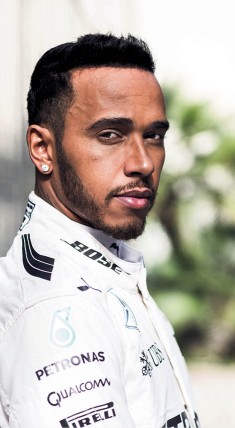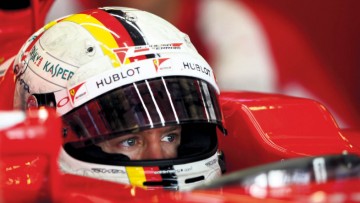Why do sponsors sponsor? It’s a question that Formula 1 fans ask a lot. After all, it is hard to see the value of having a tiny logo on a car usually found ten places off the lead in race far from the TV cameras. What’s the payback?
Benefits of partnership
One man who knows is Mark Gallagher. As head of sponsorship for Jordan Grand Prix between 1991 and 2004, and then founder of Red Bull’s sponsorship department, he has experience of getting some big brands to hand over some awfully big cheques.
“For starters, we don’t talk about sponsorship,” cautions Mr Gallagher. “It smacks of patronage. We want a partnership. Teams need to provide a wide range of benefits. These will vary depending on the brand.
Being able to talk to our customers about our work with one of the most respected brands in the world is a very big deal

Lewis Hamilton from
Mercedes, whose
partners include
Petronas, Qualcomm,
Pirelli and Bose
“For example, Vodafone is a consumer brand, so it wanted visibility on the car and at circuits, and a chance to market to the wider public. Other sponsors, the majority in fact, are business-to-business. They don’t have major branding needs. They use the sport for other reasons. Companies in data storage or analytics use F1 to create a technical case study to impress clients. The logo is not a big deal for them.”
A classic example of the latter is Ferrari partner Infor. This privately held American software company builds industrial IT systems for multinationals. Anna Wright, Ferrari sponsorship manager for Infor, confirms that the image of a mutual working partnership is totally true.
“Ferrari use Infor software for the building of their GT cars. The CIO [chief information officer] of Ferrari has just done an interview with a manufacturing magazine talking about their four-year plan using our software,” she says.
Trips to the Ferrari HQ in Maranello maximise the connection. “We take customers and potential customers to the Ferrari factory. We do events at Maranello. They get to drive cars around the track. Being able to talk to our customers about our work with one of the most respected brands in the world is a very big deal. It has a huge impact,” says Ms Wright.
B2B connections
Even consumer brands take F1 partnerships way beyond the obvious advertising stuff. Take the deodorant brand Sure Men. It supported Lotus in 2014 and this year is with Williams Martini Racing. Yes, Sure Men has a snazzy Williams special edition product coming out. But there’s so much more to the deal.
“There are three pillars,” says Willem Dinger, F1 manager at Unilever, which owns Sure Men. “From a brand perspective, F1 and motorsport gives us a great way to engage with men and their passion points. Our campaign is about protection and performing under pressure. Motorsport allows us to land those messages.” The drivers and engineers will all be applying Sure Men at races to assist this campaign.
They are helping us improve our spray drying towers, using thermal modelling to cut energy consumption, so this relationship gives us a chance to share best practices and learnings
The second ingredient is the tie-in with the Williams Advanced Engineering, the skunk works of the team focused on the commercial sector. “This is a two-way knowledge-sharing exercise between Unilever and Williams,” says Mr Dinger.
“They are helping us improve our spray drying towers, using thermal modelling to cut energy consumption, so this relationship gives us a chance to share best practices and learnings.”
And the F1 connection gives Unilever more clout when negotiating with supermarkets. “In Brazil and Russia we do barter deals. We give them assets to get ourselves better shelf position and visibility in-store. It’s just another example of the benefits we get from our involvement in F1.”
The sport is fun. Partners get to bring clients to races. It’s a major benefit. Mr Gallagher recalls “wild days” at Jordan: “I am Irish, Eddie Jordan is Irish and we played on that. We were known as the party team. We did the Silverstone rock concerts and they were massive. We had George Harrison coming. At our Monaco events we had Bono and U2.”
Brands tap into this. In the 1990s, teams like Jordan did risque photoshoots with young models dressed in the livery. Tobacco companies such as Benson & Hedges achieved incredible exposure. “It was very nineties, but the tabloids and lads’ mags lapped it up,” says Mr Gallagher.
Promotional perks
These days, events are a little more tasteful or sensitive and far more imaginative. Natalie Krushner, founder of NKrush, an agency which helps teams and grand prix host cities generate publicity, says imagination is the limit when it comes to promotional events. “We’ve done things like drive-in movie cinemas at the track or hosting a fashion show there. We’ve held roundtables at universities to engage the students,” she says.

Sebastian Vettel of Ferrari, whose partners include Kaspersky, Hublot and Shell
The essential point is that brands can get whatever they want from a deal. Ferrari sponsor Kaspersky Lab Anti-Virus has used its deal to learn about cyber security in cars, which is a growing concern as vehicles get hooked up to the internet. It has also launched into cyber security for factories and component makers.
“We have learnt how to speak the automotive language from Ferrari,” says Alex Moiseev, European managing director of Kaspersky Lab. “We are now talking to car vendors and OEMs [original equipment manufacturers] about our products.”
German technology company SAP has made huge strides through its tie-up with McLaren. SAP provides cloud storage and resource-intensive computing. It offers McLaren use of its ultra-fast SAP HANA platform to give the F1 team advanced data-crunching capabilities.
McLaren provides an angle for countless case studies and magazine articles looking at the platform. It’s a good way to showcase the technology to potential clients in the corporate world. Again, there aren’t too many consumers who make the connection between the SAP logo on the car and the world of in-memory computing. It doesn’t matter.
Ultimately, it’s the brands that decide what they get out of the sport. “My old mate David Coulthard is forever being asked to do incredible things,” says Mr Gallagher. “Red Bull got him to drive an F1 car on the helipad of the Burj Al Arab [Dubai skyscraper]. They put it on YouTube and it’s one of the most-watched clips they’ve ever done. It shows the creativity that goes on.”
In F1 anything is possible. That’s why brands keep coming back.
Benefits of partnership

